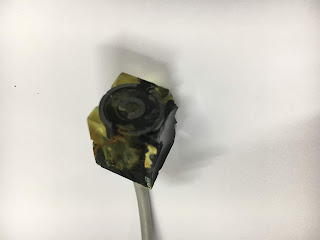Bought one of these from AliExpress recently. It's one of those electronic tool setter thingies.
It seems to be a slightly bigger brother to the one I've been using on The Shiz for some time now. It's not pretty but it has been working fairly consistently - so far.
No need to take mine apart, as Marty has already done that for us. No need to scare ourselves really but it's interesting to see what is within:
How does it connect up?
Luckily, the only instructions are in Chinese. So using the power and might of Google Translate on my iPhone, here's what I can spy:
Seems the green and yellow are the contacts that should be used for the tool length setting and the red and black are for overtravel detection. So you'd probably wire them into your e-stop circuit. Sure enough, if you depress the detector, the green / yellow changes state from closed to open almost immediately. Press further (about 1-2mm) and the red/black then go open circuit. Not sure I can be arsed to wire in the overtravel but the detector function is already wired to the front panel since I'd previously connected up my homemade detector to a 4mm banana socket.
Not sure WTF the included connector is for. It doesn't fit the conduit (which is too big), or the threaded section of the gland (ditto) and the internal cable itself is too small. Besides, the threaded gland doesn't come with a nut and it appears to be some weird thread. I measured 20 tpi and a diameter of 0.305", which makes it neither 1/4" nor 5/16". No, it's not metric either....
Mounting the fucker:
Not in the biblical sense obviously. No - it's time to make something on the lathe. I have an M10 x 1.5 die and some handy brass bar. The cable is 4.5mm diameter, so I can drill a clearance hole through, create a counterbore for the 8mm conduit and then thread the nose M10. I can then open the 6mm hole on the front panel up to 10mm and wop the thing in there.
That should do the trick. Now for the wiring....












































